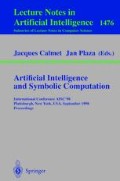Abstract
First, a short introduction to inductive logic programming and machine learning is presented and then an inductive database mining query language RDM (Relational Database Mining language). RDM integrates concepts from inductive logic programming, constraint logic programming, deductive databases and meta-programming into a flexible environment for relational knowledge discovery in databases. The approach is motivated by the view of data mining as a querying process (see Imielinkski and Mannila, CACM 96). Because the primitives of the presented query language can easily be combined with the Prolog programming language, complex systems and behaviour can be specified declaratively. Integrating a database mining querying language with principles of inductive logic programming has the added benefit that it becomes feasible to search for regularities involving multiple relations in a database. The proposal for an inductive logic programming query language puts inductive logic programming into a new perspective.
Preview
Unable to display preview. Download preview PDF.
References
R. Agrawal, T. Imielinski, and A. Swami. Mining association rules between sets of items in large databases. In Proceedings of the 1993 International Conference on Management of Data (SIGMOD 93), pages 207–216, May 1993.
R. Agrawal, H. Mannila, R. Srikant, H. Toivonen, and A.I. Verkamo. Fast discovery of association rules. In U. Fayyad, G. Piatetsky-Shapiro, P. Smyth, and R. Uthurusamy, editors, Advances in Knowledge Discovery and Data Mining, pages 307–328. The MIT Press, 1996.
I. Bratko. Prolog Programming for Artificial Intelligence. Addison-Wesley, 1990. 2nd Edition.
I. Bratko and S. Muggleton. Applications of inductive logic programming. Communications of the ACM, 38(11):65–70, 1995.
P. Clark and R. Boswell. Rule induction with CN2: Some recent improvements. In Yves Kodratoff, editor, Proceedings of the 5th European Working Session on Learning, volume 482 of Lecture Notes in Artificial Intelligence, pages 151–163. Springer-Verlag, 1991.
P. Clark and T. Niblett. The CN2 algorithm. Machine Learning, 3(4):261–284, 1989.
L. De Raedt, editor. Advances in Inductive Logic Programming, volume 32 of Frontiers in Artificial Intelligence and Applications. IOS Press, 1996.
L. De Raedt and L. Dehaspe. Clausal discovery. Machine Learning, 26:99–146, 1997.
L. Dehaspe and L. De Raedt. Mining association rules in multiple relations. In Proceedings of the 7th International Workshop on Inductive Logic Programming, volume 1297 of Lecture Notes in Artificial Intelligence, pages 125–132. Springer-Verlag, 1997.
L. Dehaspe and H. Toivonen. Frequent query discovery: a unifying ILP approach to association rule mining. Technical Report CW-258, Department of Computer Science, Katholieke Universiteit Leuven, March 1998. http://www.cs.kuleuven.ac.be/publicaties/rapporten/CW1998.html.
S. DŽeroski. Inductive logic programming and knowledge discovery in databases. In U. Fayyad, G. Piatetsky-Shapiro, P. Smyth, and R. Uthurusamy, editors, Advances in Knowledge Discovery and Data Mining, pages 118–152. The MIT Press, 1996.
S. DŽeroski and I. Bratko. Applications of inductive logic programming. In L. De Raedt, editor, Advances in inductive logic programming, volume 32 of Frontiers in Artificial Intelligence and Applications, pages 65–81. IOS Press, 1996.
T. Imielinski and H. Mannila. A database perspectivce on knowledge discovery. Communications of the ACM, 39(11):58–64, 1996.
T. Imielinski, A. Virmani, and A. Abdulghani. A discovery board application programming interface and query language for database mining. In Proceedings of KDD 96. AAAI Press, 1996.
N. Lavrač and S. DŽeroski. Inductive Logic Programming: Techniques and Applications. Ellis Horwood, 1994.
C. Mellish. The description identification problem. Artificial Intelligence, 52:151–167, 1991.
R.S. Michalski. A theory and methodology of inductive learning. In R.S Michalski, J.G. Carbonell, and T.M. Mitchell, editors, Machine Learning: an artificial intelligence approach, volume 1. Morgan Kaufmann, 1983.
T. Mitchell. Machine Learning. McGraw-Hill, 1997.
T.M. Mitchell. Generalization as search. Artificial Intelligence, 18:203–226, 1982.
S. Muggleton and L. De Raedt. Inductive logic programming: Theory and methods. Journal of Logic Programming, 19,20:629–679, 1994.
J. Ross Quinlan. C4.5: Programs for Machine Learning. Morgan Kaufmann series in machine learning. Morgan Kaufmann, 1993.
J.R. Quinlan. Learning logical definitions from relations. Machine Learning, 5:239–266, 1990.
G. Sablon, L. De Raedt, and M. Bruynooghe. Iterative versionspaces. Artificial Intelligence, 69:393–409, 1994.
W. Shen, K. Ong, B. Mitbander, and C. Zaniolo. Metaqueries for data mining. In U. Fayyad, G. Piatetsky-Shapiro, P. Smyth, and R. Uthurusamy, editors, Advances in Knowledge Discovery and Data Mining, pages 375–398. The MIT Press, 1996.
A. Srinivasan, S.H. Muggleton, M.J.E. Sternberg, and R.D. King. Theories for mutagenicity: A study in first-order and feature-based induction. Artificial Intelligence, 85, 1996.
H. Toivonen, M. Klemettinen, P. Ronkamen, K. HÄtönen, and H. Mannila. Pruning and grouping discovered association rules. In Y. Kodratoff, G. Nakhaeizadeh, and G. Taylor, editors, Proceedings of the MLnet Familiarization Workshop on Statistics, Machine Learning and Knowledge Discovery in Databases, pages 47–52, Heraklion, Crete, Greece, 1995.
Author information
Authors and Affiliations
Editor information
Rights and permissions
Copyright information
© 1998 Springer-Verlag Berlin Heidelberg
About this paper
Cite this paper
De Raedt, L. (1998). An inductive logic programming query language for database mining. In: Calmet, J., Plaza, J. (eds) Artificial Intelligence and Symbolic Computation. AISC 1998. Lecture Notes in Computer Science, vol 1476. Springer, Berlin, Heidelberg. https://doi.org/10.1007/BFb0055898
Download citation
DOI: https://doi.org/10.1007/BFb0055898
Published:
Publisher Name: Springer, Berlin, Heidelberg
Print ISBN: 978-3-540-64960-1
Online ISBN: 978-3-540-49816-2
eBook Packages: Springer Book Archive

